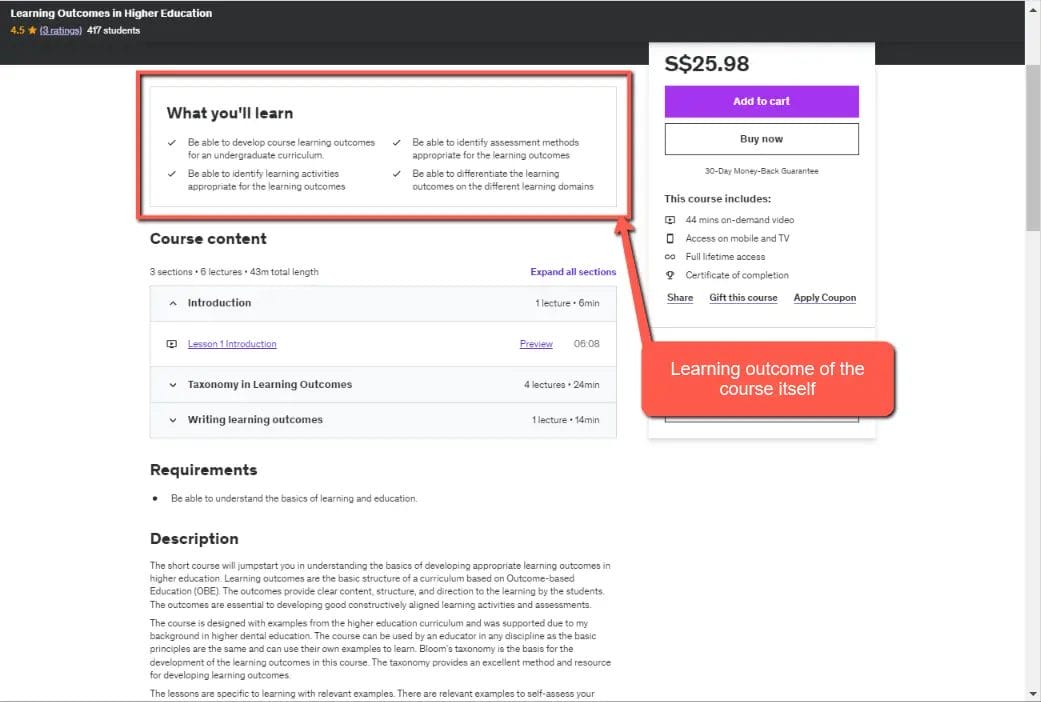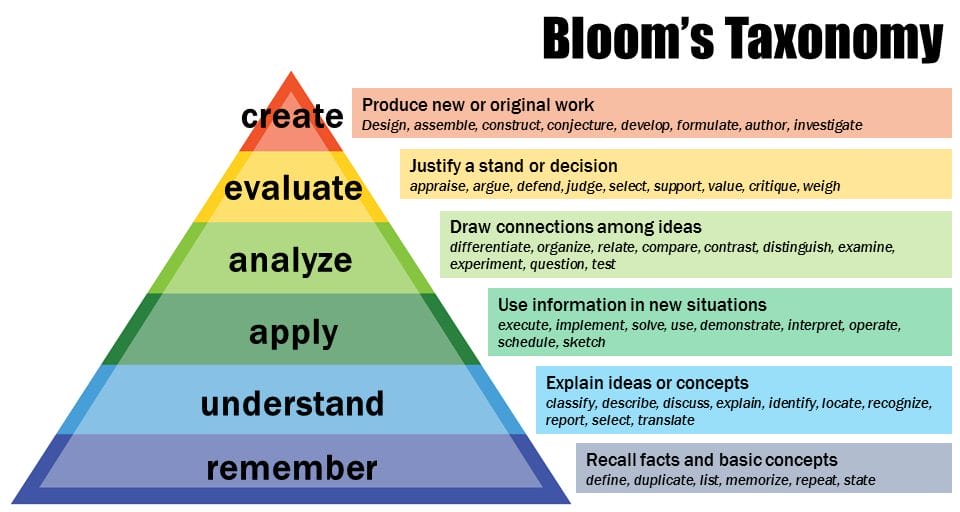How to Write Learning Outcomes and Course Outcomes (with Examples)
Wondering how to effectively write your student learning outcome for your online course? Like writing learning objectives, writing effective learning outcomes is key when creating your online course.
Developing course and program learning outcomes offers insight on what the students are expected to achieve, making it a key to your course design as the course creator .
KEY TAKEAWAYS
- Learning outcomes act as vital guides, ensuring clarity and success in online courses for both instructors and students.
- Course goals provide direction, objectives serve as checkpoints, and learning outcomes represent tangible results.
- To write learning outcome, start with action verbs, articulate specific knowledge or skills precisely, and maintain simplicity for quick understanding.
What Is a Learning Outcome for Online Course?
Learning outcomes are clear statements that describe what your students will know or be able to do as a result of completing your course.
Think of them as the signposts that guide your students’ learning experience, ensuring that both you and your students stay on track throughout the course.
Types of Learning Outcomes in Learning
When crafting your online course, you’ll encounter 5 main types of learning outcomes.
- Cognitive outcomes focus on intellectual skills, like analysis or problem-solving. These are things your students will be able to think through and understand.
- Affective outcomes are about attitudes and values; how your students will feel or what they’ll value after your course.
- Psychomotor outcomes involve physical skills and movements that, say, a dance or woodwork course might cover.
- Ethical outcomes concentrate on the development of ethical reasoning on moral implications
and repercussions. - Social outcomes address the appropriate, productive social interactions, relationships and behavior with other people.
How Is Writing a Learning Outcome Different from Course Goal and Course Objectives?
Let’s get your terms straight on the difference between Learning Outcome vs Course Goal vs Course Objectives:
- Course goal is a broad, like a compass setting the direction. It shows the big-picture aspirations of your course.
- Course objectives are specific checkpoints, think of them as the stepping stones leading to your final destination.
- Learning outcome is the actionable result from completing the course.
A learning outcome often will have the statement “the student will be able to” proving they absorbed what you taught.
It’s tied to the Center for Teaching recommendations, focusing on the end of the course and what your student can confidently do in the cognitive domain, like able to identify key concepts.
Why Learning Outcome Matters for Effective Learning

When you’re creating an online course, nailing down your learning outcomes is like setting GPS coordinates for a road trip.
Learning Outcomes for Learners and Students
For your learners, your learning outcome let you tell your students exactly where they’re headed.
Think of effective learning outcomes as checkpoints in a race. Each one you hit confirms you’re on the right track.
Learning Outcomes for Course Creators and Instructors
When you writing learning outcomes, you’re also defining success for your course.
They anchor the teaching and learning process, aligning the activities with goals. This means your content stays relevant, and you don’t wander off-topic.
Learning Outcomes for Online Course as a Whole
Your entire course is like a toolbox packed with knowledge.
Each of your learning outcome is like tool in the toolbox, where you will introduce to your student and helping them knowing how to use the tool.
With an effective list of learning outcomes, you can encourage active learning, nudge students to engage with the material, and promote higher-order thinking.
The student learning outcome statements lay the foundation for a solid online course that delivers results and keeps students hooked all the way to that final ‘congrats‘ email.
Step-By-Step Process on How to Write Learning Outcome for Online Course

Crafting clear learning outcomes is like setting up signposts for your course. They help guide both you and your students toward the destination of successful learning.
1. Begin with an Action Verb
Start each learning outcome with an action verb that corresponds to the desired level of learning.
Words like ‘identify’, ‘analyze’, or ‘design’ are powerful starters.
They immediately inform students of the actions they’ll be mastering.
- For lower-level learning, consider verbs like ‘list’ or ‘describe’.
- For more complex skills, opt for ‘evaluate’ or ‘create’.
2. Follow with a Statement that Describes the Knowledge and Abilities to be Demonstrated
After the verb, articulate the specific knowledge or skill you expect learners to demonstrate.
Be precise here.
If you want students to apply theories to real-world scenarios, explain exactly what that looks like.
Instead of “Students will understand X,” go for “Students will calculate Y using Z method.”
3. Keep Each Learning Outcome Clear, Short and Easy to Understand
Aim for simplicity and clarity.
Each outcome should be a single sentence that’s easy to grasp.
This isn’t just about being brief; it’s about making sure your students can quickly understand what’s expected of them without confusion.
Split complex outcomes into smaller chunks if needed – each should stand on its own.
Tips on Crafting Effective Learning Outcomes
1. Know Your Action Verbs
To craft effective learning outcomes, start with action verbs that capture the level of engagement and proficiency you expect from your students.
Verbs are the engine of your learning outcomes—they drive the action and spell out the skills your students will develop.
2. Use Bloom’s Taxonomy
Utilizing a learning taxonomy, such as Bloom’s, helps you categorize these outcomes, allowing you to scaffold learning from basic understanding to complex analysis and creation.
3. Be Precise
Writing student learning outcome should be precise on what you expect your student will be able to demonstrate after completing the course.
4. Focus on Assessing Student Learning
Learning outcome describe the expected level of learning and understanding on the topic.
What you write in your learning outcome should be reasonable to the level of the learners.
5. Measurable Student Learning Outcomes
When we are talking about the outcome, it needs to be measurable and the student can easily see if they are able to achieve the course outcome.
- Learners are able to [Learning Outcome].
- Learners understand how to [Learning Outcome].
- Learners can demonstrate how to [Learning Outcome].
- Learners can explain how to [Learning Outcome].
Developing Learning Outcome Examples

Crafting precise learning outcomes sets the stage for success in your online course.
They’re essentially promises to your learners about what they’ll be able to do after completing your course.
Good Learning Outcome Examples
Be Specific: Good learning outcomes aren’t vague. They tell your learners exactly what they’ll gain.
Example:
- By the end of this course, you’ll be able to write a business plan that clearly outlines your business idea, market analysis, and financial projections.
Measureable Objectives: They allow you to measure whether learners have achieved the desired skill or knowledge.
Example:
- You’ll solve advanced calculus problems with a 90% success rate.
Action-Oriented: Use active verbs that denote measurable actions.
Example:
- You’ll design a database that supports transaction processing and report generation.
Bad Learning Outcome Examples
Too Broad: Avoid outcomes that are too general or broad, leaving learners unclear on what they will learn.
Example:
- Understand business. (This is too open-ended.)
Unmeasurable Terms: Don’t use terms that you can’t measure or observe.
Example:
- Know the concept of calculus. (Knowing isn’t measurable.)
Passive Language: Steer clear of passive constructions or ambiguous verbs.
Example:
- Be introduced to database design. (This doesn’t specify what the learner will be able to do.)
Remember, the goal is for your learners to know precisely what they will learn and be able to apply.
Writing Learning Outcome With Action Verbs

When you’re crafting learning outcomes for your online course, think of these outcomes as the capstones of your course’s architecture.
You’ll want each to reflect a specific action that your students can perform once they’ve completed the course. Use action verbs to define these learning outcomes with precision.
Align the verbs with the types of skill they related to:
- Knowledge and Understanding
- Application
- Analysis
- Synthesis and Creativity
- Evaluation
Here’s a cheat sheet of action verbs organized by the type of skill they relate to:
| Skill Type | Verbs | Verbs | Verbs |
|---|---|---|---|
| Knowledge and Understanding | State List Describe Define | Outline Explain Summarize Interpret | Identify Recall Recognize Classify |
| Application | Apply Demonstrate Solve Use Prepare | Perform Predict Implement Execute | Utilize Practice Compute Illustrate |
| Analysis | Analyze Compare Question Examine | Distinguish Debate Differentiate Investigate | Infer Categorize Break down Separate |
| Synthesis and Creativity | Create Design Formulate Organize Construct | Plan Develop Generate Invent | Compose Combine Rearrange Integrate |
| Evaluation | Evaluate Judge Assess Recommend Criticize | Defend Revise Justify Validate | Prioritize Appraise Argue Interpret |
Using these action verbs from bloom’s taxonomy for learning in crafting your learning outcome can help you to set clear expectations.
For instance, asking students to describe the impact of a historical event provides a different insight than requesting them to evaluate its consequences.
However, when writing your learning objectives, here are some pointers to consider:
- Vague words like “understand” or “learn” are tougher to measure and less action-oriented, so they’re best avoided.
- Application and result -oriented words like “solve” or “develop” are easier to measure and more action-oriented, so they’re often used.
Pick verbs that match the cognitive skill you’re targeting – whether it’s recalling facts, applying knowledge in practical settings, dissecting concepts, combining ideas into something new, or making judgments based on criteria.
Learning outcomes are measurable will sharpen your focus and aid your students in grasping what’s expected of them.
Are You Ready to Write Your Student Learning Outcomes?
Your learning outcomes not only shape your course content and activities but also help measure student engagement and success.
They are foundational to your course’s effectiveness and are closely linked to the assessment strategies you’ll employ.
Leveraging the support and resources from a center for teaching and learning can further refine these outcomes, aligning them with best practices in online education.
Learning outcomes are statements that helps to make sure you and your students are speaking the same language and marching toward a shared victory flag.
- 7 Best Teachable Alternative for Course Creators (Free and Paid)
- LearnWorlds Features: In-Depth eLearning LMS Overview
- ThinkiFic Features: Course Creator’s In-Depth Overview
- 200+ Best Online Course Ideas For New Course Creators of Every Niche (Updated)
- +59 Best Proven Membership Site Ideas to Get Started This Year (Read First)
Join 900+ BUDDIES who are growing their wealth with our weekly Income Newsletter
Antony C. is a dividend investor with over 15+ years of investing experience. He’s also the book author of “Start Small, Dream Big“, certified PMP® holder and founder of IncomeBuddies.com (IB). At IB, he share his personal journey and expertise on growing passive income through dividend investing and building online business. Antony has been featured in global news outlet including Yahoo Finance, Nasdaq and Non Fiction Author Association (NFAA).


